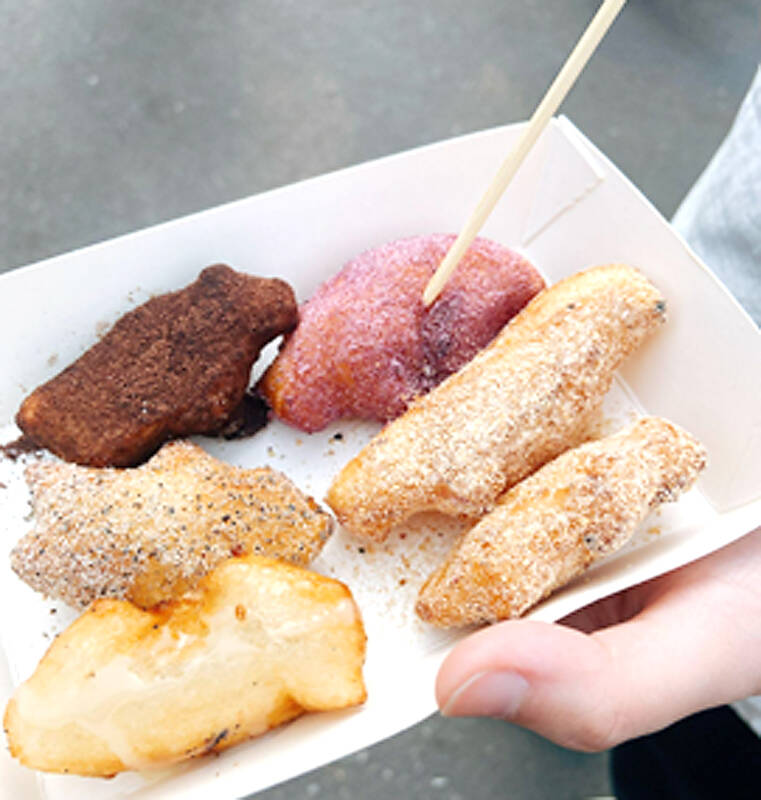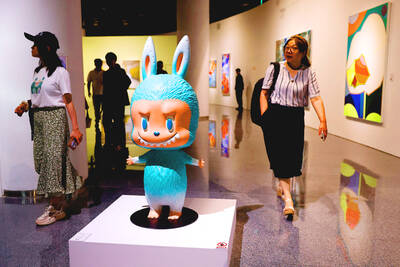Like people in many other countries, Taiwanese are fond of delicious fried snacks. For example, Spain is known for its churros, and in Taiwan there is a traditional fried dessert made of sticky rice called beh teung guai. The snack consists of sticky rice flour that is mixed with water, kneaded into a dough and shaped into small pieces. Once fried, the sticky rice balls are coated in crushed peanuts and sugar mixture.
世界上有許多國家愛吃炸甜點,台灣也不例外。舉例來說,西班牙有吉拿棒,台灣人則有油炸糯米的點心──白糖粿。作法先將糯米粉和水混合揉成糰,再捏成小塊,炸好後裹上花生糖粉。
knead (v.) 揉(麵糰、黏土),捏;捏製;揉捏形成

Photo courtesy of Bookman l 圖片:書林
Beh teung guai is a traditional snack that has been enjoyed by many senior citizens since childhood, but it is not just for the older generation. Today, vendors are adding new and innovative flavors to this classic snack, making it a popular snack among all age groups. Besides the classic crushed peanuts and sugar coating, beh teung guai is now available in various flavors like coffee, chocolate and matcha. Some vendors also offer a roasted wheat flour flavor, which was in the past often mixed with water to make a popular and nostalgic drink. These simple desserts have once again become popular due to the creativity of shop owners who have added colorful coatings to attract the attention of passersby.
白糖粿是許多長輩從小吃到大的傳統甜點,但不是只有長輩愛吃,許多攤商發揮創意,除了經典的花生糖粉口味,還可以選咖啡、可可、抹茶等各式各樣的口味,有的店家還提供麵茶粉口味,麵茶是台灣古早味飲品。這道簡單的甜點藉由商家的創意再次成為人氣美食,裹著七彩繽紛的糖粉,吸引路人的目光。
roasted wheat flour (n. phr.) 麵茶粉
The origin of fried beh teung guai comes from a sticky rice ball known as “teung guai” which is boiled in water. The ball has a dent in the middle to represent a bowl holding the countless tears shed by the Chinese goddess Zhinu (also known as Qixing Niangniang). Zhinu was the youngest daughter of the Jade Emperor. She is best known for her role in the Chinese folk tale “The Cowherd and the Weaving Girl” which is the origin of Chinese Lovers’ Day. One day she went down to Earth and fell in love with a cowherd, but her father the emperor disapproved of their marriage. He used the Milky Way galaxy to separate them, but allowed them to meet only once a year on Zhinu’s birthday on the seventh day of the seventh month (Qixi). Each year the lovers have to cross the Milky Way using a bridge built by magpies (the Magpie Bridge) to see each other.
白糖粿是自「糖粿」演變而來。糖粿其實就是湯圓,每顆糖粿中間會壓上凹痕,代表用來裝織女眼淚的碗。織女尊稱為七星娘娘,她是玉皇大帝最年幼的女兒,為中國神話故事〈牛郎織女〉中的仙女,她的故事是東方情人節「七夕」的由來。織女下凡遊歷時,愛上了人間的牛郎,然而她的父親玉帝不同意他們的婚事,於是用銀河將兩人分開,每年只有在織女的生日七夕(農曆七月初七),兩人才能跨過銀河,於鵲橋上相會。
dent (n.) 凹痕;(v.) 凹下;塌陷
Jade Emperor 玉帝,天帝
disapprove (v.) 不同意
Milky Way (n. phr.) 銀河
Zhinu’s tragic love story elevated her to become the patron of love and children. In some cities like Tainan or Changhua, children at the age of 16 worship Qixing Niangniang with teung guai during the Qixi Festival to thank her for her blessings over the previous sixteen years. Unmarried men and women can also worship Qixing Niangniang because she reports information about them to the Heavenly Court in the hopes a suitable partner can be matched to them.
織女和牛郎悽婉的愛情,使織女成為愛情和孩子的守護神。每年七夕,在台南、彰化等地,若家中有16 歲的孩子,會準備糖粿當供品,以感謝織女十六年來的保佑。世間未婚男女也會拜七星娘娘,因為她可以上報天庭,讓合適的單身男女可以配對。
elevate (v.) 提升...職位
patron (n.) 守護神
文章由書林出版公司提供:
www.bookman.com.tw

What comes to mind when you think of a “mermaid”? For some, it may simply be a mythical creature, but being a professional mermaid is a real and fascinating career. This unique job not only involves creativity but also demands dedication and skill. Professional mermaids amaze audiences with breathtaking underwater performances. Whether they are gracefully swimming alongside marine creatures or educating spectators about manatee ecology, their movements evoke a sense of magic and wonder. But their work doesn’t stop there. Many mermaids engage directly with visitors, taking memorable photos or guiding them through unique experiences, such as “mermaid for

A: A mint Labubu doll was sold for a record 1.08 million Chinese yuan — or about US$150,300 — at an auction. B: That much for a doll? That’s insane. A: The character of toy company Pop Mart has sparked a global frenzy thanks to celebrity endorsements, like pop diva Rihanna and Blackpink member Lisa. B: Where can we admire all the Pop Mart dolls? A: The world’s third Pop Mart flagship store is located in Taipei’s Ximending area. Let’s go together. A: 一個薄荷色的「拉布布」玩偶在拍賣會上,拍出108萬人民幣天價、高達15萬美元! B: 一個玩偶?這也太瘋狂啦。 A: 這個泡泡瑪特玩具公司旗下的角色正在全球掀起狂熱,而這都要感謝天后蕾哈娜、Blackpink的Lisa等名人的加持。 B: 哪裡可以看到泡泡瑪特推出的公仔啊? A: 全球第三家泡泡瑪特旗艦店就在台北西門町,我們去逛逛吧。 (By Eddy Chang, Taipei Times/台北時報張迪)

A: What are some of the hottest auction items other than the Labubu doll? B: NBA player Stephen Curry’s basketball card, actress Jane Birkin’s Hermes “Birkin bag,” and Princess Diana’s dresses also attracted robust bidding recently. A: How much can a trading card cost? B: Curry’s Paris Olympics autograph card was sold for US$518,500, or NT$15.3 million. A: Wow, it broke the record held by MLB superstar Shohei Ohtani’s baseball card. That’s amazing. A: 除了 「拉布布」玩偶以外,還有哪些熱門拍賣品? B: NBA球星史蒂芬柯瑞的球卡、女星珍柏金的原版愛馬仕「柏金包」、戴安娜王妃的禮服最近都引發競標。 A: 一張卡片能有多貴啊? B: 哈這張印著柯瑞在巴黎奧運的簽名卡,拍出51萬多美元天價、高達台幣1,530萬! A: 哇他打破了MLB球星大谷翔平球卡的紀錄,真是令人驚奇。 (By Eddy Chang, Taipei Times/台北時報張迪)

The traditional five-day workweek was introduced around a century ago and has since become the standard, along with punching in at 9am and leaving at 5pm. Recently, however, challenges to this formula have been increasing, particularly among young people. In the UK, 200 British companies have changed gears and decided to adopt a permanent four-day workweek for their employees. The new schedule will not cause any loss in pay, which is expected to result in greater employee satisfaction. Among those leading the charge for the new model are charities, marketing firms, and technology companies. Advocates of the policy say